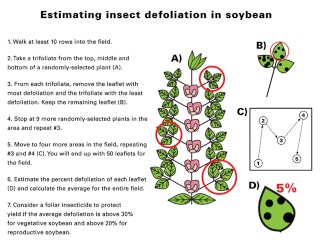By Terry Basol
When it comes to soybean, one of the most common types of injury is defoliation from insects. This damage can be easily detected in the canopy by observing holes in the leaves or along leaf margins as insects with chewing mouthparts consume leaf tissue. The insects most responsible for defoliation are bean leaf beetles, Japanese beetles, and grasshoppers. There are numerous caterpillars that also cause soybean defoliation, including green cloverworm, soybean looper and alfalfa caterpillar.
Soybean plants can tolerate a fair amount of feeding without suffering significant yield loss due to their capacity to compensate from defoliation by insects. Research has shown a key factor that drives soybean yield loss from defoliation is the reduction of light interception of the canopy. As long as the remaining leaves can intercept at least 90% of the light, soybean can still maintain 100% of their yield potential. Therefore, the size of the remaining soybean canopy is crucial when making pest management decisions. The larger the size of the canopy, the greater tolerance for leaf loss.
Timing of insect feeding as it relates to the soybean growth stage is also important to consider when making a treatment decision. Soybean can tolerate defoliation in the vegetative stages more than during reproductive stages. Environmental and growing conditions should also be considered, as favorable conditions will favor regrowth and compensation (due to ample moisture, optimum temperatures, etc.). Replicated data over multiple growing regions consistently show economic thresholds for soybean defoliation are 30% in the vegetative stages and 20% in the reproductive stages. This threshold applies to the entire field. Sometimes these pests cause significant injury only along field margins. In these situations, perimeter treatments may be more cost effective, if practical.
It is difficult to estimate defoliation in the field and can easily be overestimated. This is due to the varying species and different areas of the canopy they feed on. All areas (upper, mid, and lower) of the canopy need to be evaluated for a valid defoliation estimate. To help reduce bias, use the leaflet sampling method shown in Figure 1 (below).

Figure 1. Scouting recommendation for estimating defoliation in soybean. Graphic by Erin Hodgson
Practice with estimating defoliation is important in order to train your eyes and minimize the chance of overestimating when conducting evaluations in the field. There are some great tools available to help, like the online Soybean Insect Defoliation Training from the Crop Protection Network. This allows you to hone your assessment skills to accurately estimate the amount of leaf area defoliated by insect pests. One of the unique features of this tool is that it allows you to change the defoliation prior to taking a practice quiz. Another relatively new tool available is a phone/tablet app that is free and open sourced called LeafByte. This app uses your camera to measure the total leaf area, consumed leaf area, and percent consumed or defoliated. You can learn more about how the app works at https://zoegp.science/leafbyte.
In summary, it’s important to scout and monitor soybean throughout the growing season as the insects that cause defoliation are continuously active. Remember to consider the soybean growth stage, environmental conditions, and size of the soybean canopy when evaluating injury and making treatment decisions.
Source : iastate.edu